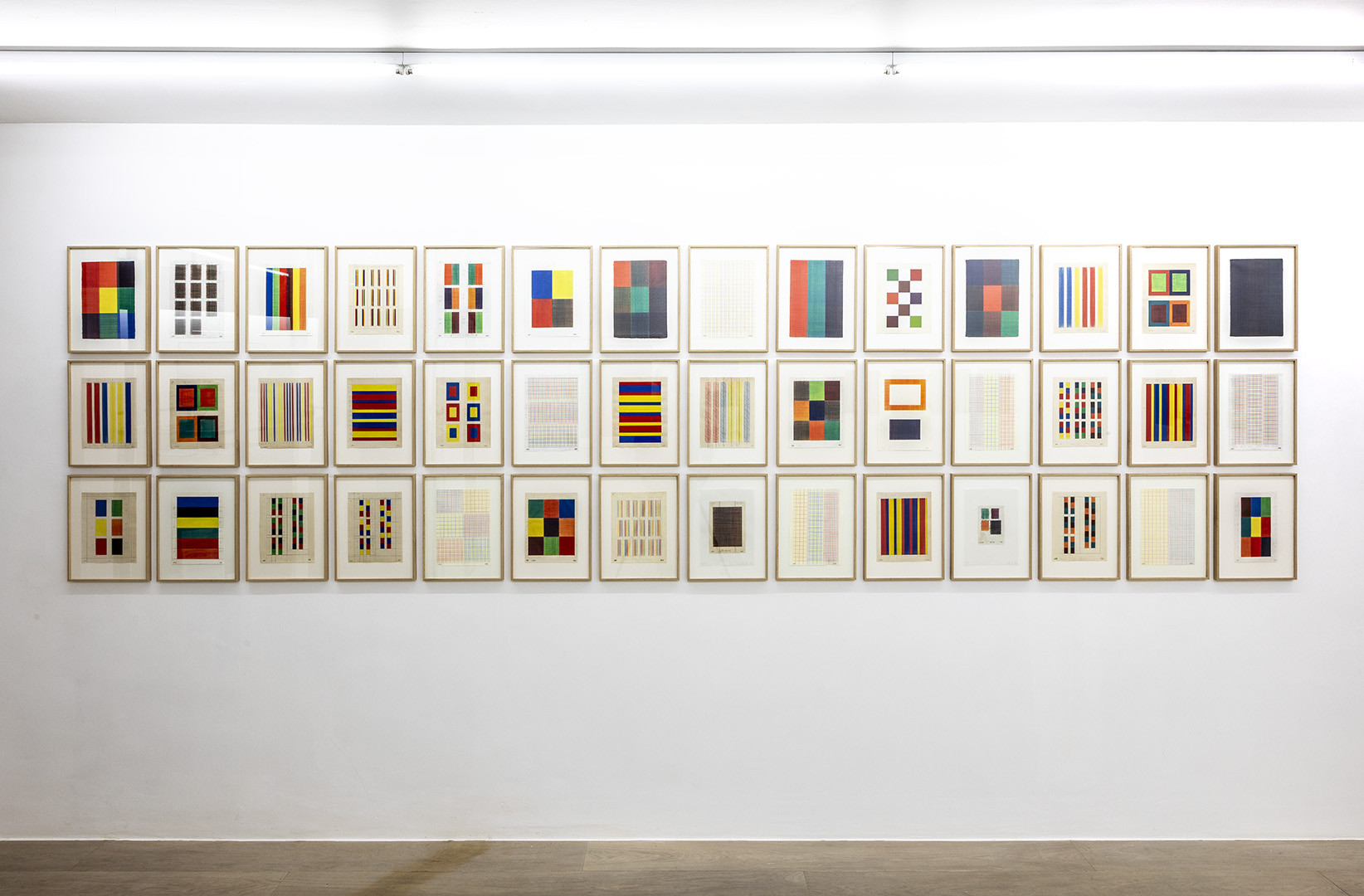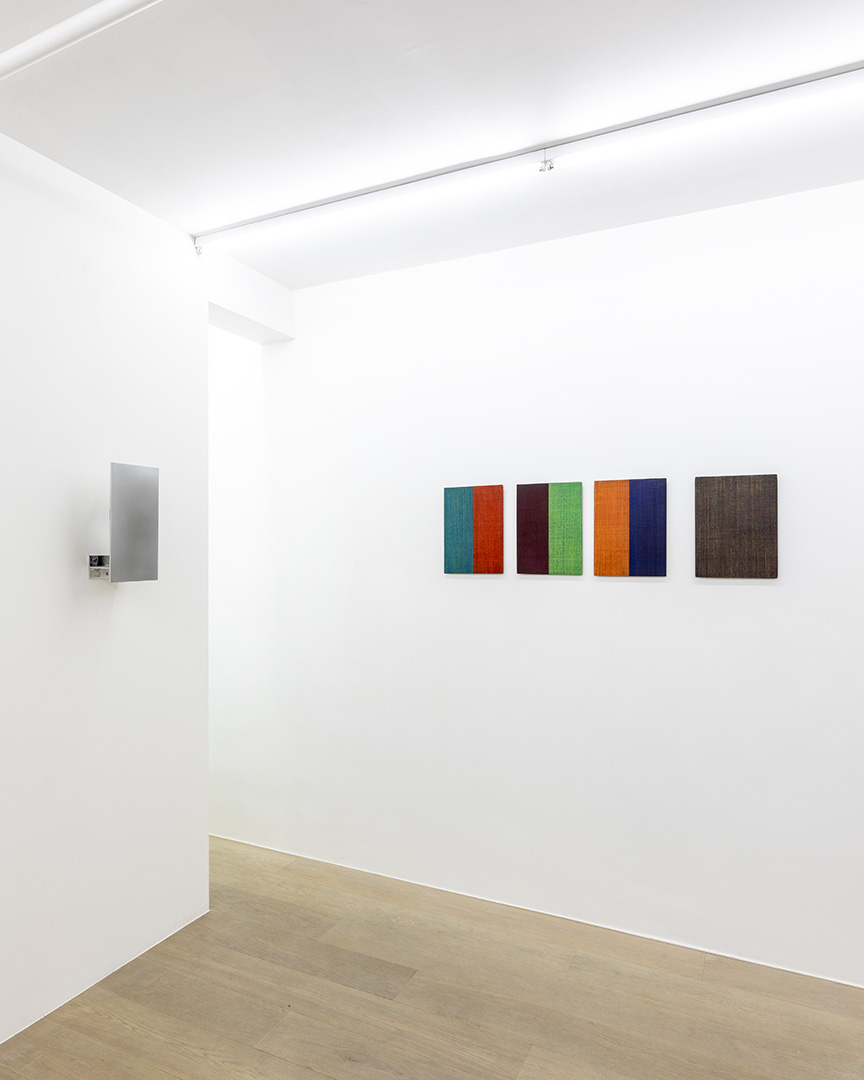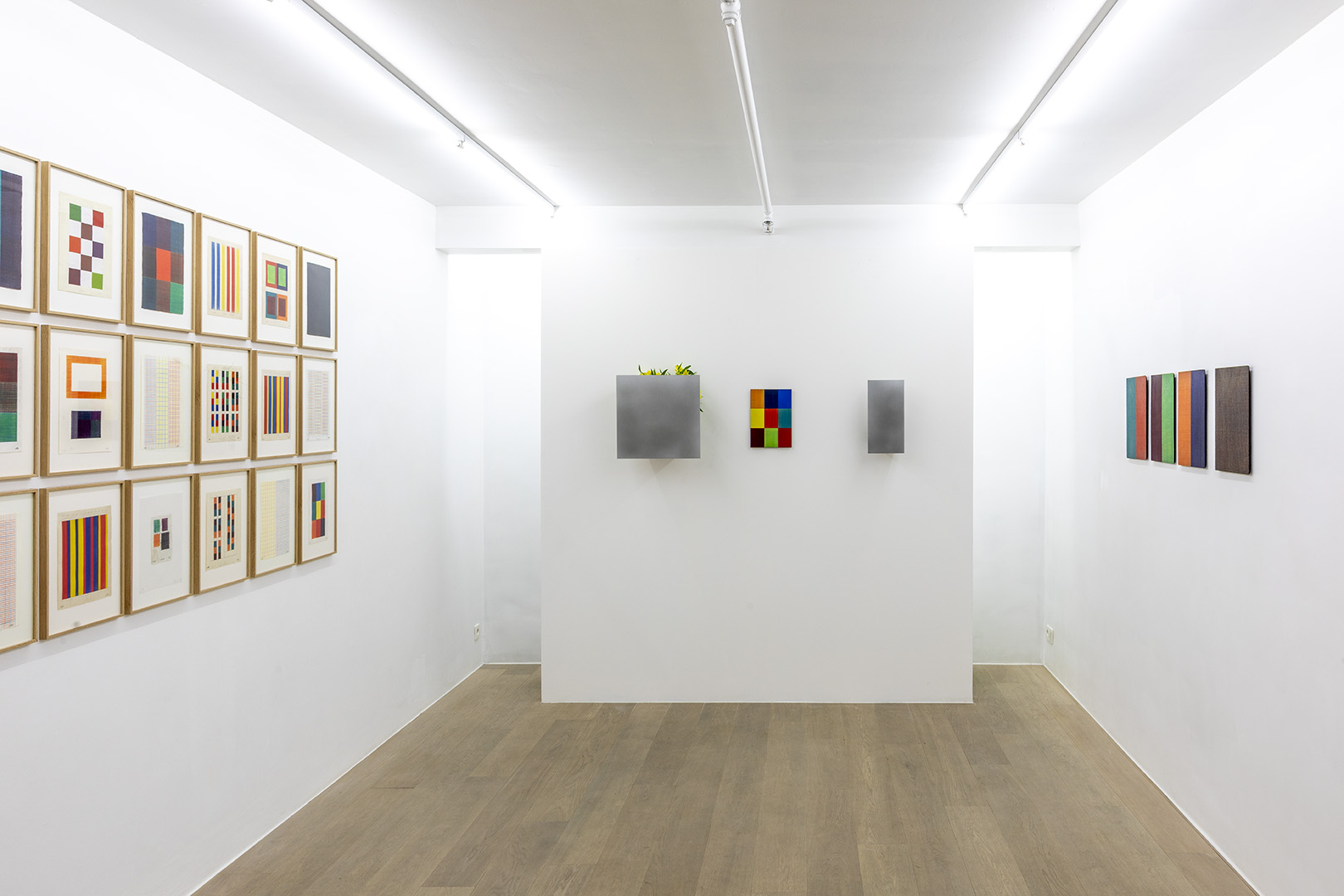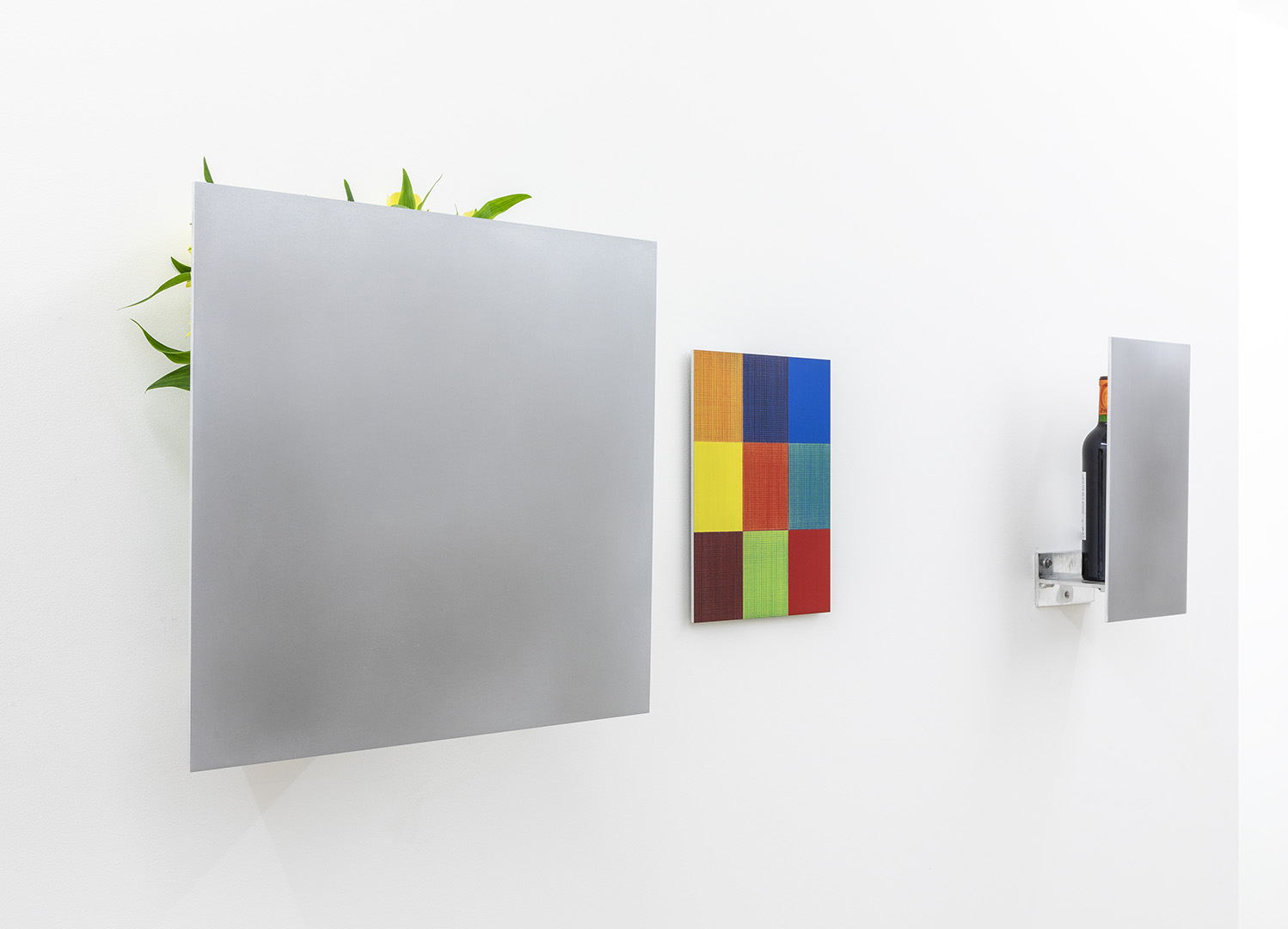Generically colouring, generously living
Life is ironic.The more one has, the less one needs. For Willem Cole (1957) a few dashes are enough. Preferably on paper, or on slate, with a pencil. And in two colours, more or less together, so a third appears by itself. Behold, the fate of a master draughtsman, a virtuoso. The less room there is left for the many things he is able to draw, or for the irrevocably singular gesture, the more he finds the essence in the few things he devotes himself to. Beauty as discipline. To name the kind of beauty with which he likes to surround himself, Cole only needs three words: 'Couleurs, fleurs et vin'. It is the title of his latest exhibition at Galerie Zwart Huis in Brussels, fifteen years after the even more restrained 'Color' (2006) in Knokke. And it is indeed the little that tells a lot. It almost sounds like an aesthetic formula, an artistic credo. After all, colours, flowers and wine not only refer to the beautiful, even frivolous side of life: life as a sensual gift, in an echo of the 'luxury, calm and voluptuousness' evoked by Baudelaire in Les fleurs du mal (1857). In their multiple simplicity, they also mention the basic components of the artificial paradise that the artist designed for himself. Not mentioningthe friends, of course, to whom he has always preferred to give them, in conceptual portrait series such as Deux couleurs and Je vous donne des fleurs.
The act of giving, be it wine, flowers or other gifts , is indeed the basic gesture that Cole evokes. But what is particularly intriguing is how he links the generous to the generic in doing so. A bottle of wine and a bunch of flowers are of course always beautiful and always good, but as gifts they risk being worn out for cliché and inspiration. In other words: too generic. Exactly that, however, is what attracts Cole, because theie generic character allows him to focus on the gesture itself, the core of dedication that forms the essence of every gift and that is sometimes hidden because of the emphasis on the private and the original. Visually, he resolves this by placing flowers or a wine bottle behind a hard steel plate, with at most the tip still visible, so the beauty is evoked by what cannot be seen. But the underlying principle with which Cole exchanges the gift for the gesture is more general. Compare it to someone lighting a candle in a church. The thing itself matters little, all candles are the same, but through the ritual gesture it becomes the recipient of a thought, an object that is henceforth the inalienable medium of the attention that was devoted to it. .
In the same way Cole finds the spiritual in the generic – inspiration in wine included, especially when you know that his artistic ideas often originate in bars and are elaborated later on in his studio. It also explains why he is able to capture the work of so many years almost light-heartedly in general and generic concepts. More than cheerfully empty words, colours, flowers and wine are the elementary details of his oeuvre, the letters of his alphabet, a small series allowing infinite combinations, with colour as the alpha and omega. For Cole is a colourist. Colour is his medium, colour is his blood - much more than painting or drawing. Just as some people want to ‘give blood’, Willem Cole ‘gives colour’. And just as the colour of blood always has something indefinably unique, even though the composition of basic substances is always the same, Cole also shows, in a sustained minimalist effort, the inexhaustible variation that arises from simply bringing together (basic) colours, always in search of the unique in the generic. It distinguishes him as a colourist in a conceptual wayIn response to Barnett Newman one could say that no oneless afraid of red, yellow and blue than he is.
This is because his art is ultimately an 'ars combinatoria'. Cole deliberately reduces it to something elementary, the element 'colour'. But unlike the modern tradition which reduced visual art to its basis in colour, line or flatness, such as Cole’s own mentor Dan Van Severen did, with Cole reduction is not a goal in itself, a method of aesthetic purification. On the contrary, it is a way of not being seduced or distracted by a certain aesthetic, a way of being as open as possible to life and people’s subjective colouring of it. What he aims for by reducing his art by means of colour to its most generic elements are therefore not the so-called basic colours as pure aesthetic ideas, but rather the vital energy that is set free by their systematic reconstitution. Pencil line after pencil line, drawing after drawing, he is amazed at the way in which more or less juxtaposed colours become optically interwoven. And what he is looking for in this is not the exhaustion of all possibilities for combining and shading, but the very key to his amazement itself: how can so much be in so little?
Eventually, this whole artistic endeavor seems to be on the lookout for something that equals the beauty of a mathematical formula. This kind of beauty isn’t impacted by singular impulses or particular results. It lies in the generic logic of a system (or a generative principle) that extracts a maximum of possibilities out of a minimum set of resources. Just as science has shown that all life is composed of DNA, in an infinitely varying spiral staircase of four bases with proteins as the binding element, likewise the art of Willem Cole, based on three basic colours with more or less white space in between, demonstrates how a manifold of varieties can emerge out of utterly limited set of basic differences. In a strict application of the ‘less is more’-principle, through a reductio ad absurdum, and confidently conscious that one plus one gives three. Maybe that sounds rather complicated, but in reality it is very simple, simple in a multiple way. Translated to life, the formula can simply be synthesized by ‘couleurs, fleurs et vin’.
In the end one can of course wonder whether that is a lot or only a little, just as you may doubt whether life is complicated or not. But as soon as you do so, you are already encapsulated by the sense of wonder that is at the heart of this work. By the strict logic of an art that, far from favouring a specific or exclusiveaesthetic, just wants to give space to life in its multiple colours, freely and without a preconceived goal. For that is the moment when you realize again that each of Cole's works is the result of a thought dedicated to another person: from the artists that inspire him (Yves Klein, Blinky Palermo, Donald Judd, ...) up to friends and relatives that he portrays using two colours of their own choice. nYou cannot really see these acts of dedication, of course; for that the portraits are -too generic and conceptual. But exactly this makes you aware that the essential beauty of Willem Cole’s artistic formula resides in what remains not-formulated. It is beautiful in what it cannot grasp, ironic as life itself.Generic, but generous.
Tom Van Imschoot
Life is ironic.The more one has, the less one needs. For Willem Cole (1957) a few dashes are enough. Preferably on paper, or on slate, with a pencil. And in two colours, more or less together, so a third appears by itself. Behold, the fate of a master draughtsman, a virtuoso. The less room there is left for the many things he is able to draw, or for the irrevocably singular gesture, the more he finds the essence in the few things he devotes himself to. Beauty as discipline. To name the kind of beauty with which he likes to surround himself, Cole only needs three words: 'Couleurs, fleurs et vin'. It is the title of his latest exhibition at Galerie Zwart Huis in Brussels, fifteen years after the even more restrained 'Color' (2006) in Knokke. And it is indeed the little that tells a lot. It almost sounds like an aesthetic formula, an artistic credo. After all, colours, flowers and wine not only refer to the beautiful, even frivolous side of life: life as a sensual gift, in an echo of the 'luxury, calm and voluptuousness' evoked by Baudelaire in Les fleurs du mal (1857). In their multiple simplicity, they also mention the basic components of the artificial paradise that the artist designed for himself. Not mentioningthe friends, of course, to whom he has always preferred to give them, in conceptual portrait series such as Deux couleurs and Je vous donne des fleurs.
The act of giving, be it wine, flowers or other gifts , is indeed the basic gesture that Cole evokes. But what is particularly intriguing is how he links the generous to the generic in doing so. A bottle of wine and a bunch of flowers are of course always beautiful and always good, but as gifts they risk being worn out for cliché and inspiration. In other words: too generic. Exactly that, however, is what attracts Cole, because theie generic character allows him to focus on the gesture itself, the core of dedication that forms the essence of every gift and that is sometimes hidden because of the emphasis on the private and the original. Visually, he resolves this by placing flowers or a wine bottle behind a hard steel plate, with at most the tip still visible, so the beauty is evoked by what cannot be seen. But the underlying principle with which Cole exchanges the gift for the gesture is more general. Compare it to someone lighting a candle in a church. The thing itself matters little, all candles are the same, but through the ritual gesture it becomes the recipient of a thought, an object that is henceforth the inalienable medium of the attention that was devoted to it. .
In the same way Cole finds the spiritual in the generic – inspiration in wine included, especially when you know that his artistic ideas often originate in bars and are elaborated later on in his studio. It also explains why he is able to capture the work of so many years almost light-heartedly in general and generic concepts. More than cheerfully empty words, colours, flowers and wine are the elementary details of his oeuvre, the letters of his alphabet, a small series allowing infinite combinations, with colour as the alpha and omega. For Cole is a colourist. Colour is his medium, colour is his blood - much more than painting or drawing. Just as some people want to ‘give blood’, Willem Cole ‘gives colour’. And just as the colour of blood always has something indefinably unique, even though the composition of basic substances is always the same, Cole also shows, in a sustained minimalist effort, the inexhaustible variation that arises from simply bringing together (basic) colours, always in search of the unique in the generic. It distinguishes him as a colourist in a conceptual wayIn response to Barnett Newman one could say that no oneless afraid of red, yellow and blue than he is.
This is because his art is ultimately an 'ars combinatoria'. Cole deliberately reduces it to something elementary, the element 'colour'. But unlike the modern tradition which reduced visual art to its basis in colour, line or flatness, such as Cole’s own mentor Dan Van Severen did, with Cole reduction is not a goal in itself, a method of aesthetic purification. On the contrary, it is a way of not being seduced or distracted by a certain aesthetic, a way of being as open as possible to life and people’s subjective colouring of it. What he aims for by reducing his art by means of colour to its most generic elements are therefore not the so-called basic colours as pure aesthetic ideas, but rather the vital energy that is set free by their systematic reconstitution. Pencil line after pencil line, drawing after drawing, he is amazed at the way in which more or less juxtaposed colours become optically interwoven. And what he is looking for in this is not the exhaustion of all possibilities for combining and shading, but the very key to his amazement itself: how can so much be in so little?
Eventually, this whole artistic endeavor seems to be on the lookout for something that equals the beauty of a mathematical formula. This kind of beauty isn’t impacted by singular impulses or particular results. It lies in the generic logic of a system (or a generative principle) that extracts a maximum of possibilities out of a minimum set of resources. Just as science has shown that all life is composed of DNA, in an infinitely varying spiral staircase of four bases with proteins as the binding element, likewise the art of Willem Cole, based on three basic colours with more or less white space in between, demonstrates how a manifold of varieties can emerge out of utterly limited set of basic differences. In a strict application of the ‘less is more’-principle, through a reductio ad absurdum, and confidently conscious that one plus one gives three. Maybe that sounds rather complicated, but in reality it is very simple, simple in a multiple way. Translated to life, the formula can simply be synthesized by ‘couleurs, fleurs et vin’.
In the end one can of course wonder whether that is a lot or only a little, just as you may doubt whether life is complicated or not. But as soon as you do so, you are already encapsulated by the sense of wonder that is at the heart of this work. By the strict logic of an art that, far from favouring a specific or exclusiveaesthetic, just wants to give space to life in its multiple colours, freely and without a preconceived goal. For that is the moment when you realize again that each of Cole's works is the result of a thought dedicated to another person: from the artists that inspire him (Yves Klein, Blinky Palermo, Donald Judd, ...) up to friends and relatives that he portrays using two colours of their own choice. nYou cannot really see these acts of dedication, of course; for that the portraits are -too generic and conceptual. But exactly this makes you aware that the essential beauty of Willem Cole’s artistic formula resides in what remains not-formulated. It is beautiful in what it cannot grasp, ironic as life itself.Generic, but generous.
Tom Van Imschoot



